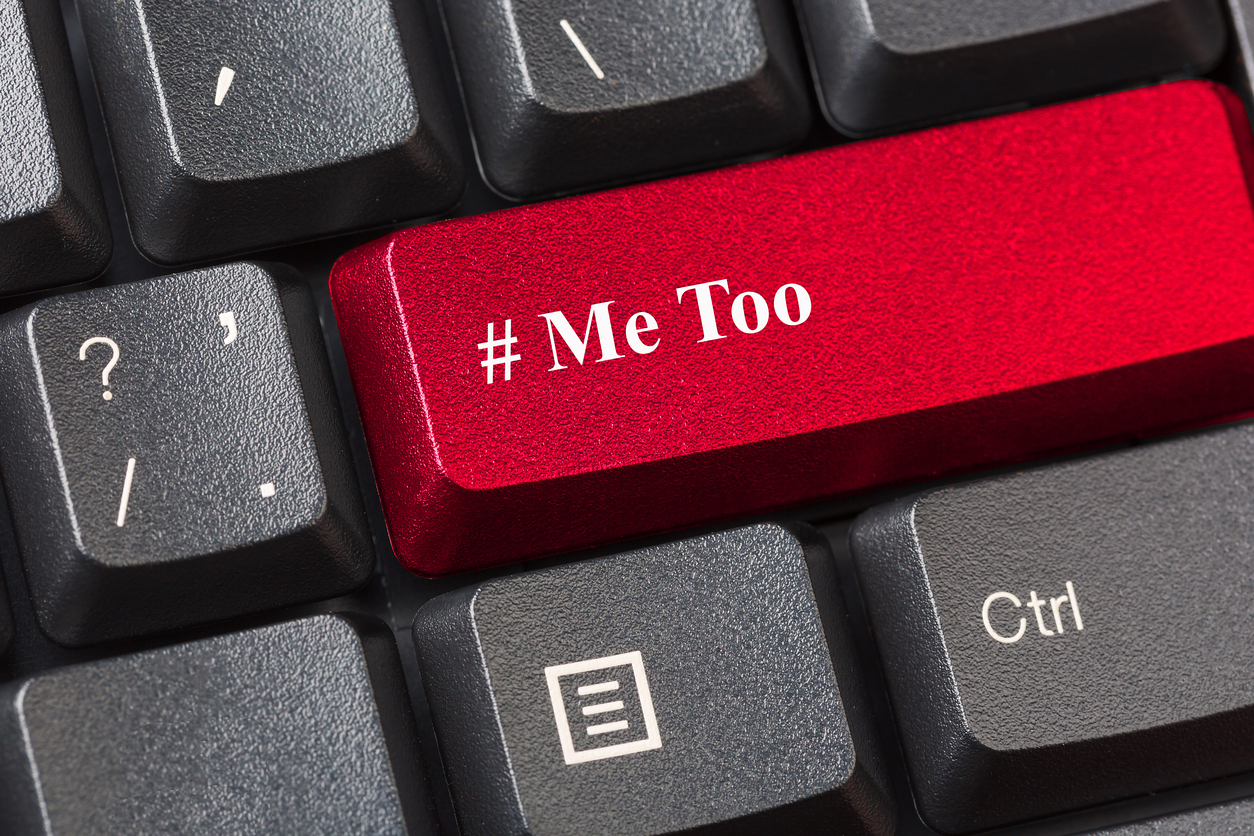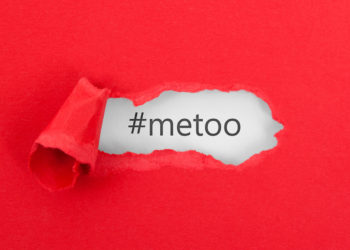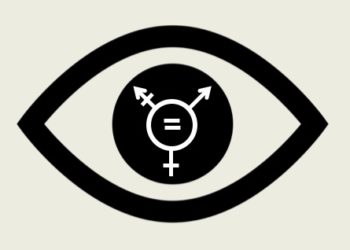The past week or so has been an extraordinarily difficult one for many of us as we once again watch a woman’s emotional, authentic and convincing testimony all but ignored in favor of deferring to the righteous indignation of a privileged white man. Yet in spite of that, real progress has been made across industries, including our own. Two weeks ago, I moderated the closing panel at ALPSP on this topic and as one of the Twitter comments noted at the time:
“These stories, the need for this session, makes me angry. But it also makes me hopeful. We’ve gone from denying that this is a problem in our industry to a closing plenary at one of our most important conferences.”
There was so much great advice that I wanted to share it with a wider audience.

As the #MeToo movement broke a year ago, I waited eagerly for someone to speak out on my behalf – on behalf of the many women across scholarly communication of all ages who like me had been subject to harassment in its many forms. My post here back in February was in part a result of my own anger at the silence, and it’s one of the pieces that has helped us begin this conversation in scholarly communication. I’d like to thank and give huge kudos to ALPSP for not only welcoming this panel, but also for recognizing its importance and making it a plenary session.
The ultimate goal for our panel was to help each other create organizations in which no one of any gender or gender identity has to experience what I and so many others have. We also wanted to create an understanding of what creates cultures in which this kind of toxic behavior survives and most importantly, to give attendees practical actions to take away for themselves and their organization. Our speakers included Dr. Afroditi Pina, a researcher at the University of Kent whose research focuses on sexual violence against women and men, and Femi Otitoju, Training Director at Challenge Consultancy who deliver bespoke interventions for organizations on the creation of inclusive and respectful workplaces. On the publishing side, we had Karen Phillips, SVP, Global Learning Resources at SAGE Publishing and Eric Merkel-Sobotta, Vice President, Communications & External Affairs at De Gruyter.
Our panel began with some brief context and framing:
- What do we mean by sexual harassment? Sexual harassment includes a range of behaviors from unwanted comments to physical assault, but research shows that gender harassment is the most common form. Such behavior — “the put-downs as opposed to the come-ons” – conveys the impression that women do not belong in the workplace or do not merit respect. They can seriously affect the person targeted, and they also set the stage for the other types of sexual harassment: unwanted sexual attention and sexual coercion.
- How much harassment is there? In the most comprehensive examination of workplace sexual harassment ever done in a longitudinal study, the Youth Development Study found that 46% of women had experienced some form of sexual harassment by age 31. But one of the pernicious aspects of harassment is the difficulty of knowing precisely what’s going on, how much of it is going on, and who’s doing it. (Femi noted wryly at one point that she has had clients complain that there’s more harassment after she has been working in their organization – of course, it was always there, it’s just that no one felt empowered to talk about it.)
- Most training is ineffective: We’ve all been there- clicking through a PowerPoint or attending a mandatory seminar at which someone lectures about harassment while attendees glance at their phones. At best, research has found that this type of training succeeds in teaching people basic information, like the definition of harassment and how to report violations. At worst, it can backfire by reinforcing gender stereotypes because it tends to portray men as powerful and sexually insatiable and women as vulnerable.Either way, it usually fails to address the root problem: preventing sexual harassment from happening in the first place.
- It’s the culture, stupid: To actually prevent harassment, companies need to create a culture in which women are treated as equals and employees treat one another with respect. And I’d argue that it’s not simply the organizational culture – the Kavanaugh hearings have foregrounded this societal challenge again, and Mary Beard captures it perfectly in her recent book, Women and Power (which, as Lettie Conrad noted in a tweet, should be required reading!):
“You cannot easily fit women into a structure that is already coded as male; you have to change the structure…. We have to be more reflective about what power is, what it is for, and how it is measured. To put it another way, if women are not perceived to be fully within the structures of power, surely it is power that we need to redefine rather than women?”
At an organizational level, research has continually shown that companies with more women in management have less sexual harassment. It’s partly because harassment flourishes when men are in power and women aren’t, and men feel pressure to accept other men’s sexualized behavior.
But how can we move to the practical level of making real change as individuals and in our own organizations?
For organizations, we heard about the critical importance of creating the right culture. One interesting lesson from Femi was the importance of language – in her work, she focuses on building dignity at work rather than talking about harassment and bullying (in other words, focus on the outcome you want). Unsurprisingly perhaps, it’s also important that these messages and initiatives are led by senior leadership for them to carry real weight and meaning.
Both Femi and Afroditi focused on the importance of clear, accessible processes for reporting, investigating and resolution. Harassment flourishes in organizations where there is risk perceived in complaining, and where there aren’t adequate sanctions for harassers. It’s sobering to know that according to 2012 data, 35% of women still don’t report at all and a further 66% only tell a friend, partner or relative. Just 10% report at work. Victims coping strategies fall into five broad types: advocacy seeking (formal complaint, grievances); social support (family, friends); avoidance; denial; and confrontation/negotiation with the harasser. Our reporting and support strategies need to be able to accommodate the full range of responses, and so we need to ensure that we have advisors and reporters trained across all levels and departments. Femi talked about the need for closure and learning for both the victim and the respondent. Victims need safe space to talk and for support, choice and control in what happens, and practical changes that address what has happened. But respondents also need an opportunity to learn (especially in the majority of cases that may not likely demand termination), to take responsibility, to talk safely and to be treated with respect. This is especially true in the #MeToo era where lives have the potential to be destroyed without due process.
Karen talked about how SAGE has been developing and implementing a dignity at work policy. They have started with training for all managers and are now considering how best to cascade this throughout the organization. SAGE also tried training that didn’t quite work, which was focused more on what and what not to do in a particular situation. Eric also added additional cross-cultural perspectives on how to address harassment, and the complexity of trying to codify what isn’t and isn’t acceptable across geographies and cultures.
Equally importantly, SAGE is highlighting the policy for all of their external partners – authors, editors, and vendors on their website and in contracts. We talked about how crucial this was in an industry where we have many junior- and mid-level staff traveling and working with those in more powerful positions (whether customers or authors). It sets a strong, positive example if an organization is prepared to walk away from a powerful perpetrator – whatever their business value – and an equally bad one if such behavior is tolerated. And while there is much that SAGE can do on its own, Karen also noted the need for us to work collectively us publishers – both to create an industry we are proud of and in which everyone can flourish, and to ensure that we don’t simply pass problem employees, authors or vendors between ourselves.
And while much of our discussion focused on women, it’s important to recognize that both straight and gay men are also harassed, and that minorities of any kind are at higher risk. The recent NASEM report found that LGBTQ women and women of color were more likely than their straight, white counterparts to have been harassed, and women of color were more likely to report feeling unsafe because of their gender. But there is a dearth of data on the experiences of underrepresented minorities and other marginalized groups.
For individuals, the most important take away is that we all have a responsibility to stamp this behavior out. In other words, if you see something, say something. This is not just the case for sympathetic women, but very much for men. If you’re a man, be willing to amplify the voices of women who have identified a problem – women didn’t create these issues and we need your active support to eradicate this conduct.
And whatever your gender identity, if anyone comes to you and asks you to change something about your behavior, Femi noted that the first words out of your mouth should be “thank you”. That may sound surprising, but think about it. This person has had the courage and respect to talk to you directly, to think that you’re worth investing and to give you the chance to change your behavior. If we all start to practice this, we’ll begin to create an environment in which it’s much easier for all of us to say “I don’t like that” without it becoming a big deal.
If you’re in a management role, take a proactive stance if you think there’s an employee whose behavior is problematic, even if you don’t have proof. A conversation that starts “I’ve no proof but I’ve got this hunch there’s something going on with your behavior” can help someone realize they need to change before it goes too far.
One of the ideas I loved most from Femi and plan to use back at PLOS is the idea of reverse mentoring. Those of us at more senior levels can all too easily lose touch with the challenges of starting out. In this model, you have junior members of staff who are vulnerable take on mentoring roles for those who are more senior so that they can have some insight as to what it feels like to be in that position in the organization.
One of the great questions in the Q&A, was about how to handle the employee who reports an incident to you but tells you they don’t want you to do anything about it. The answer to that should be “Sorry, but I have a responsibility to look after you and so I can’t promise you that. I promise I won’t do anything without telling you and that I’ll take what you want into account in whatever I do, but I cannot let you go through this in the workplace.” We all need to set the standard that such behavior is simply unacceptable.
Femi left us with ten top takeaways, which I’ll close with here:
- Clear statement position: use it in every media you can in your organization
- Supporting policy and procedure – weave it into the DNA of the organization
- Inclusion in handbook and induction – get people to sign them
- Training for all existing staff (as well as new staff)
- Specific briefings for leaders – strategic governance approach at this level
- Clarify individuals understanding – needs local interpretation at team and 1 to 1 level
- Evidence communication of policy – get staff to sign it
- Set up support and reporting mechanisms – clear, easily accessible
- Monitoring of reporting and outcomes – keep an eye on the patterns to see if there are particular pressure points
- Regular review of policy
There’s much richness in our discussion and the following Q&A, so if you’d like to explore this in more detail, the slides from the panel are available here, and you can watch a recording of the discussion on the You Tube channel here. And we’d love to hear your own experiences about what does and doesn’t work – please share below!
Discussion
12 Thoughts on "Tackling Harassment and its Roots in Scholarly Communication: Practical Steps for Organizations and Individuals"
These are all invaluable points that I think we all hope most organizations are implementing (or have implemented). The one that particularly struck me (in light of what we’ve been hearing about over the last few weeks in the media) is number 2 on the list: Putting procedures to combat harassment into the DNA of an organization. Its one of the hardest things to achieve from scratch but one of the most effective in protecting staff and the organization going forward. You can see that at the Humane Society which has taken recent steps to clean house. http://www.humanesociety.org/news/press_releases/2018/10/workplace-culture-100118.html
I’m very impressed that SAGE has put their policy up for external partners. It’s no secret that some authors/editors are….difficult, and often the only way to deal with it is to ignore it. As a young-looking female editor, I’m fortunate that I haven’t had any overtly sexual comments, but I’ve definitely had thinly-veiled comments that indicated I was too young or green to know what I was doing (to say nothing of the times I’ve been shouted at, blamed, or otherwise insulted). When you have to get a project done, calling out bad behavior is, frankly, not usually productive. If SAGE indicates publicly that they are willing to walk away from people who treat their employees that way, then they get a standing ovation from me.
I think this is a really important point — as scholarly publishers, we’re not only dealing with the culture of our own industry, but also overlapping significantly and interacting with the culture in academia.
FYI – this is a link to SAGE’s policy statement on our website: https://uk.sagepub.com/en-gb/eur/third-party-anti-harassment-and-bullying-policy. We intend to change the title to our Dignity at Work Policy. We also refer to this in our author and editor contracts asking signatories to familiarize themselves with the policy and abide by it. I think it would be powerful if other publishers did the same. Or, if you have already made similar statements, to share what those look like for us all to learn how to confront harassment of our employees effectively.
I would also say that training managers to support employees who face difficult situations is key. I can’t recommend Femi and Challenge Consultancy highly enough for their training on both harassment and more broadly on diversity issues (unconscious bias, and inclusive leadership training).
Hi Alison, thanks for the great article and I am sorry to have missed what sounds like a brilliant session. I just wanted to echo the need to not think of this as a gender or race issue – everyone has a right to work in a respectful, safe and pleasant environment. I have been struck recently someone talking to me about cruel and thoughtless comments that I would have associated with the school playground (through painful memories), and would never have expected to hear in a work place – we have to eradicate that kind of thing as well as putting in place the very practical steps you describe to address harassment more broadly. I am also lucky enough to have a reverse mentor and can recommend it as a great way to see things through a new perspective. Thanks for all the practical tips – putting this into practice now, and not just talking about it, is going to be key for us all.
I’m so glad to see so much attention given to this, and I’m especially glad to see SAGE is taking action when it comes to external parties. While there’s a lot employers can/are doing when it comes to sexual harassment in their own companies, an area that often gets left behind is what to do when you are harassed in a professional setting by someone who doesn’t work with/for your company. For example, it has been my experience that a woman managing a booth alone at a conference is almost guaranteed to be put in an uncomfortable situation by a conference attendee, vendor or exhibitor. Women have to endure men talking about their looks instead of the product at hand, or pressuring them to join them for plans later that evening (when it’s clear the intent is not to talk business) or even pressuring them to give/take personal cell phone numbers. Sadly, the more you experience this the more you learn how to deal with it effectively, but when you’re young, inexperienced and worried about the repercussions from saying no, you often feel like you simply have to endure it. It would be phenomenal if companies would take a stance similar to SAGE’s, where they make it explicitly clear that they have their employees’ backs in these types of situations so that the next time a potential author approaches a woman alone at a publishing booth and asks for her number in an inappropriate way, that employee can feel safe and confident in saying no.
The Scholarly Kitchen, an important and substantive resource for our community, is allowing itself to become a forum for political and social commentary, assertions about “social justice,” (which many would not distinguish from “justice,”) and related topics that are more appropriate for debate among social scientists rather than a publication that is relied upon for continuing education, not indoctrination. In the article above, the author writes “…woman’s emotional, authentic and convincing testimony all but ignored in favor of deferring to the righteous indignation of a privileged white man.” Couldn’t a reasonable person also complain that a woman’s experience was leaked to the press against her wishes? Couldn’t a reasonable person also complain that a man has been accused of an assault that, to date, can not be corraborated? One might also wonder why it’s appropriate to specifically identify the race and socioeconomic class of the accused if we are not to make generalizations about skin color and class when considering individuals.
If you read beyond the first sentence, you will see that the entire focus of this post is on how we can individually and collectively work to stamp out workplace harassment. That’s not political, it’s about creating respectful, healthy and productive organizations and I – along with many of our readers – happen to think that’s an entirely appropriate focus for the Scholarly Kitchen. As for your other questions, yes of course those things are not only possible but do happen – but we know from the data that false reporting is a very small percentage of reported harassment and assault. And that lack of reporting or dismissal of reported accusations are far bigger problems. As for the mentions of other demographics, the truth is that these are the people who have held – and to a large extent still hold – many of the positions of power not only in politics but in our organizations. And they have not and all too often still don’t take complaints of harassment and assault seriously. But rather than focusing exclusively on my first sentence – and perhaps allowing for the fact that yes, as someone who has experienced sexual harassment multiple times I may, like many, feel angry and emotional about our current situation, I’d encourage you to read the full article which I’d argue is a very balanced approach to tackling an all-too-pervasive problem.
I strongly agree that harassment (and bias, diversity, inclusion and other topics around social justice) are indeed within the remit of The Scholarly Kitchen. These are issues that affect many (most?) of us in our professional lives – acknowledging and addressing them is critical in order for scholarly communications to survive and thrive.
I’m really sorry I was unable to attend your panel in person Alison but this write up is definitely the next best thing. A really invaluable and practical resource, which I’ve already shared with colleagues and which I hope will form the basis for future discussions about tackling harassment.
Thank you!
Thank you for your article! I was unable to attend your panel. Like many women I too have experienced gender harassment. I spoke up, my story was published and very few listened or even believed; even when I armed myself with legal counsel, not much has changed. Still, I live with hope because we all have to. Again many thanks for writing this piece.
Bravo…. well said!!!
My harassment made news in NY and elsewhere indeed, and yet the institution that fired me had the nerve to do an exhibition last year that is absolutely hypocritical: “uptown: nasty women/bad hombres”–On View June 13 – November 5, 2017.
http://www.vanityfair.it/news/societ%C3%A0/13/04/30/troppo-brutta-licenziata-margarita-aguilar-foto
What can I say? We need to keep speaking out!



